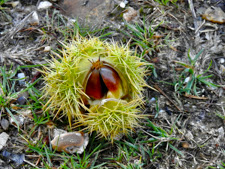The weather made this walk quite lovely. After the rain and fierce wind on Wednesday, Thursday morning turned out to be calm, mild and sunny. We started from the Bolderwood car park, escaping north across the lawn before a large coach could offload a school group, later seen equipped with grids to carry out plantlife surveys. The lawn with its old Hollies and Crab Apple trees had a good number of birds, with numerous Pied Wagtails and Chaffinches and a few tits, a Greenfinch and a Firecrest being seen by some. The route took us around the edge of a wood with many ancient Holly trees. Sadly a lot of these old trees are afflicted with a fungal parasite which is killing some of them. However, there were a good number of female Hollies with impressive crops of berries.
 |
| Turkeytail © Glynis Payne |
 |
| Turkeytail in close up © Richard Smith |
Walking downhill on the W side of the wood there is a fine view out over Bratley wood and Beckley bottom. A Raven flew over us. The path led us past the area of fields, known as the Deer Sanctuary, where a herd of Fallow Deer are fed from April to September. We saw a group of distant females and juveniles. The antlered males start their annual rut in September, so they may have been resting up after a dawn wrestling bout.
The Hollies on this part of the walk have major
bark scarring high up on their trunks. There was a difference of opinion
on whether these marks were from pony teeth, deer teeth or deer antlers.
 |
| Sweet Chestnut © Glynis Payne |
 |
| Dyer's Mazegill © Richard Smith |
A Great Spotted Woodpecker was seen at close quarters here, a Buzzard flew low across the deer fields and later a Jay was also seen and heard. A few Hornets were buzzing around, perhaps a nest nearby?
From this point on, much of our attention was
focused on the ground, as a fine range of mushrooms was seen and
photographed. At one point the
school group passed us, much amused by seeing Richard lying full length photographing
a pile of pony poo (actually the delicate parasol-like fungus growing on it).
 |
| Glistening Inkcap © Richard Smith |
 |
| Penny Bun or Cep © Glynis Payne |
Through a gate into the enclosure and down towards the Bratley Water, which later joins Blackwater and then the Lymington River. The path here is an official cycle track and we were also lucky to see a group who had brought their pony and trap for a ride through the forest.
 |
| Cauliflower Fungus © Glynis Payne |
Common Puffball © Glynis Payne
We stopped for a break at a sunny spot with wh, Sweet Chestnut, Rowan, Scots Pine, Larch, Yew, Norway Spruce ….. and then my knowledge of trees failed me on the multitude of other evergreens.elcome benches. A number of butterflies had been seen: Speckled Wood and fresh looking pair of Red Admirals. Dor Beetles were found at a number of points alongside the track. There are a great variety of trees along this walk, some apparently planted several hundred years ago. We identified Pedunculate Oak, Turkey Oak, Beec
 |
| Porcelain Fungus © Glynis Payne |
Our route followed the red marked Radnor Trail
which winds up and down a few slopes. At one point we heard a raptor
calling nearby. It didn’t sound like a Buzzard and we hoped it might have
been a Goshawk.
A short way off the main path lies the Radnor stone, a standing slab erected in 1970 commemorating the Earl, who was a verderer in the 60s. Its main charm is the series of carvings of creatures of the forest. More mushrooms were found here, a crumbling cauliflower type and a fine fat Penny Bun Boletus edulis. I hope the photos posted here will give you a taste of the fascinating fungi to be found at this time of year. JD
 |
| Our route © Crown copyright 2022 Ordnance Survey. Media 005/22. The licence is valid until 31 December 2022 |

